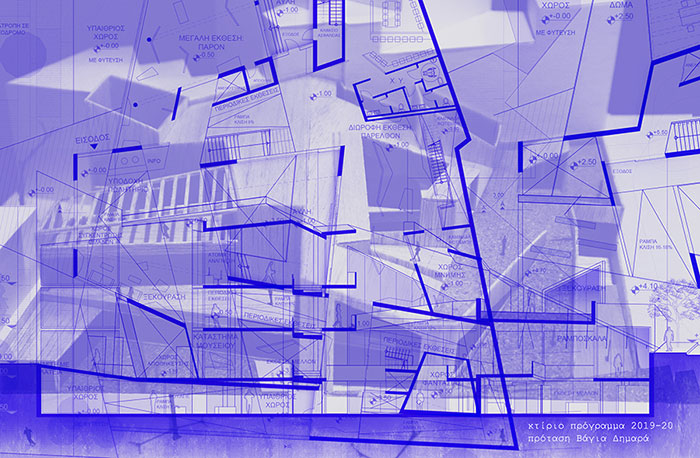Design Studio Required Elective at semester(s) 5, 7, ECTS: 12
Generic Competences: Ability to search for, process and analyse information from a variety of sources using the necessary technologies, Ability to adapt to and act in new situations and cope under pressure, Ability to make reasoned decisions, Ability to work autonomously, Ability to work in a team, Ability to work in an interdisciplinary environment, Capacity to generate new ideas (creativity), Ability to design and manage projects, Ability to interact constructively with others regardless of background and culture and respecting diversity, Commitment to conservation of the environment, Ability to demonstrate social, professional and ethical responsibility and sensitivity to gender issues, Ability to be critical and self-critical , Ability to promote free, creative and inductive thinking.

Analysis, Synthesis, Evaluation
Through this active laboratory (Design Studio) we will attempt to design a public building serving as a museum in the era of climate change, uncertain conditions and social transformation.
Through design and redesign, “construction” and “deconstruction”, doubting, diagrams and narration, theoretical approaches and interpretations, students are provided with the design tools needed for the creation of a modern contemporary public building.
This workshop allows students to experiment, test things, get tested test themselves, explore curiosity and weirdness, approaching scientific knowledge, but also self-knowledge and knowledge of the Others, through creation, equality, doubting, but mostly freedom of action.
The main objective of this course is to use characteristic modules and parameters to allow unpredictable, multifactorial and pluralist proposals, developing skills, means, and extending the participants’ imagination, poetic and artistic side to possibilities they probably never knew they had.
After the end of this course, students will be:
· Able to select and prepare the subject and building program of a museum as a public building according to the present-day social, climate, technological and cultural requirements and developments.
· Familiarized with the main literature regarding the subject “Building-Building Program”.
· Introduced to the museological and museographic design, the movements, the atmosphere and evolution of museums as public buildings.
· Able to deal with construction issues: structural system, parameterization of load-bearing structure, bioclimatic approaches and materials.
· Able to design 3D models, scale models, representations and diagrams of their proposals.
The course is structured in 10 characteristic modules-parameters representing essentially small exercises for the students:
#0 On-site #2_museums_in_Volos
#1 Contextualism
#2 Topologies
#3 “Functions”
#4 Typologies
#5 Narrations
#6 Movements
#7 Atmospheres
#8 Structural systems
#9 Plans-Facade
#10 Design
The course’s main focus is on the procedure of developing, processing and acquiring awareness of the “hows” of a project, without a given building program, but within a specific cultural, social and natural environment. The needs identified, the readings, the interpretations, the conversions, the enrichment and doubting of the design during its development are some of the main stages that form part of the design process.
Based on Bloom’s taxonomy, after the end of this course students will have developed the following knowledge, abilities and skills to:
Remember, Understand (interpret), Apply, Analyze, Evaluate and Create based on their expression means, but also based on the knowledge and skills they have acquired. Additionally: Planning – Time management, Emotional involvement, but also Motivating students to make this course part of their life, use it as a getaway and enrich it with their talents.
Böhme, Gernot, Ólafur Elíasson, and Juhani Pallasmaa. Architectural atmospheres: On the experience and politics of architecture. Walter de Gruyter, 2014.
Eisenman, Peter. "Post-functionalism." Oppositions 6 (1976): 19-21.
Forty, Adrian, and Adrian Forty. Words and buildings: A vocabulary of modern architecture. Vol. 268. London: Thames & Hudson, 2000.
Hill, Jonathan. Immaterial architecture. Routledge, 2006.
Hill, Richard, and Dick Hill. Designs and their consequences: architecture and aesthetics. Yale University Press, 1999.
Hooper-GreenhillEilean, Το μουσείο και οι πρόδρομοι του. ΠΙΟΠ, 2012.
MalrauxAndré,Το φανταστικό μουσείο. Πλέθρον, 2008.
Roaf, Sue, Manuel Fuentes, and Stephanie Thomas-Rees. ΒΙΟΚΛΙΜΑΤΙΚΟΣ ΣΧΕΔΙΑΣΜΟΣ ΚΤΙΡΙΩΝ & ΕΦΑΡΜΟΓΕΣ ΑΝΑΝΕΩΣΙΜΩΝ ΠΗΓΩΝ ΕΝΕΡΓΕΙΑΣ, Ψύχαλος, 2009.
Schumacher, Thomas. "Contextualism: Urban Ideals and Deformations'(1971)." Theorising a New Agenda for Architecture (New York, ny: Princeton Architectural Press, 1996), P 301.
Tschumi, Bernard. Architecture and disjunction. MIT press, 1996.
Ventury, Robert. Hπολυπλοκότητακαιηαντίφαση.Kατσούλης,1997.
